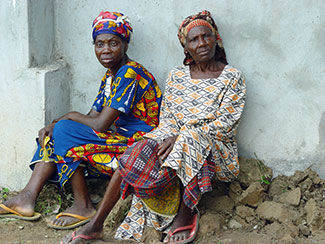Tackling the growing, global burden of dementia
September / October 2018 | Volume 17, Number 5

©2003 Shehu Danlami Salihu, Courtesy of Photoshare
Eldery women in Nigeria.
By Shana Potash
Every 3 seconds, somewhere in the world, there’s a new case of dementia, according to Alzheimer’s Disease International (ADI). One of the most burdensome conditions, dementia robs people of their memories, reasoning and independence and takes a staggering physical, emotional and financial toll on the individual, their family and society at large. Many experts are predicting a global epidemic that is expected to hit low- and middle-income countries (LMICs) particularly hard.
Dementia is an umbrella term for several diseases that, for the most part, cause progressive changes in the brain that can affect thinking, behavior and the ability to perform even simple, everyday tasks. Alzheimer’s disease, the most common form, is believed to account for 60-70 percent of all cases. Increasingly, evidence suggests a combination of genetic, lifestyle and environmental factors influence the risk of dementia and how it progresses. With that, scientists are moving beyond a one-size-fits-all approach and are examining the heterogeneity of disease - how Alzheimer’s and related dementias differ among individuals and across groups.
Researchers throughout the world are coming together to discover new or better interventions to delay, treat or prevent dementia. And they’re studying how to support the wellbeing of family members who may experience anxiety, depression and other challenges as they tend to a loved one who needs round-the-clock care.
“This is a critical time in Alzheimer’s research, with new opportunities to build upon what we have learned,” said Dr. Richard Hodes, director of NIH’s
National Institute on Aging (NIA). Equipped with increased federal funding and guided by recommendations resulting from regular stakeholder summits, NIA is leading the U.S. government’s research effort to prevent and effectively treat Alzheimer’s and related dementias by 2025, a goal of the National Plan to Address Alzheimer's Disease, established in 2012. “We must continue to foster creative approaches that leverage emerging scientific and technological advances, establish robust translational infrastructure for rapid and broad sharing of data and research tools, and work with funding partners and other stakeholders to cultivate and sustain an open science research ecosystem.”
NIH is supporting several international research collaborations to find treatment and prevention solutions, identify risk and protective factors, and collect comparable data that would enable analysis of worldwide trends. Also, a number of research and capacity building projects in LMICs have been supported through Fogarty’s brain disorders program, with funding from across NIH. To encourage more collaboration and coordination, NIA and the Alzheimer’s Association developed a database of publicly and privately funded research around the world, the International Alzheimer’s Disease Research Portfolio (IADRP).
Noting that only 15 percent of World Health Organization member states have a national plan to address dementia, WHO last year produced a global action plan that calls for a doubling of the output of global research on dementia by 2025.
More Information
Resources and publications related to the article
Study in India sets stage for US tests of screening tool for cognitive impairment:
- Related NIH-supported projects in NIH RePORTER:
- Related publications:
Resources and publications related to the article
Brazilian brains focus of Alzheimer’s genomics research:
Resources and publications related to the article
Fogarty grantees receive supplemental funding for training in Alzheimer’s disease and related dementias:
Resources and publications related to the article
As dementia rises in Africa, urgent need for research:
To view Adobe PDF files,
download current, free accessible plug-ins from Adobe's website.